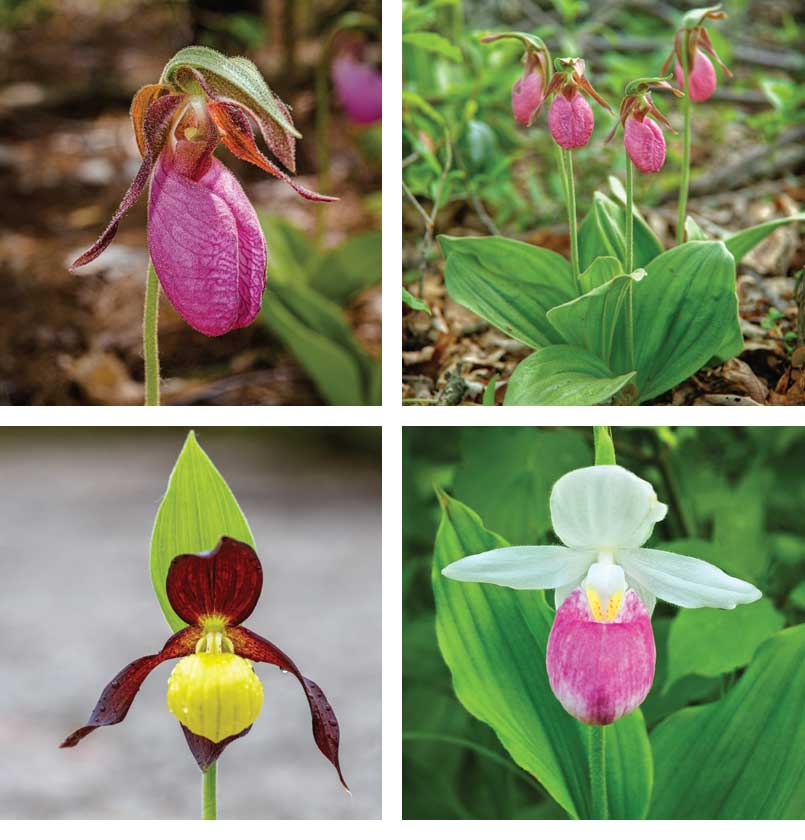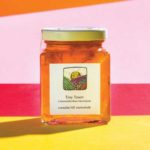
Upper right and left: Pink lady's slipper Lower Left: Yellow lady’s slipper Lower right: Showy pink lady’s slipper
Catching a glimpse of a wild orchid is a rare experience. These exquisite plants hide their beauty in the depths of damp woodlands, emerging from decaying leaf mulch to flower in quiet splendour.
We may think of orchids as rare and exotic plants grown only in greenhouses. But the blooms we see in corsages and beautiful floral showpieces represent only one branch of this fascinating family of flowers. In fact, wild orchids thrive across Canada in environments as varied as peat bogs, prairie ecosystems and even gravel pits. And as many as 50 varieties of orchid are found in Ontario.
Across the globe there are some 30,000 different species found in the Orchidacea family, representing an impressive ten percent of all the world’s seed plants. These non-woody perennials are found in every type of climate zone and on every continent except Antarctica. While there is widespread diversity within this large family, orchids do share a number of common characteristics that make them recognizable. These characteristics include bilateral symmetry (left and right halves that mirror each other), flowers that “resupinate,” or twist 180 degrees as they open, and the fact that they have very small seeds.
Orchids have complex pollination systems – with a host of even more complex variations. But that very complexity requires that they remain in bloom for a long time, which helps explain why they’re a favourite among plant fanciers.
The most common orchids found in Watershed country are the lady’s slippers, which come in three varieties: yellow, pink and showy.
The Wildflowers of Prince Edward County website compiled by the late Court Noxon tells us the yellow lady’s slipper comes in two sizes: the smaller one grows in wet sites and the larger in shady, damp hardwood forests. Watch for its flowers, two to four centimetres in size, blooming in June. It takes sharp eyes and possibly a long hike to find them, as they are rare in this part of the province.
The pink lady’s slipper, also known as the moccasin flower, is found throughout eastern North America, particularly in the Great Lakes region. It may look delicate, but it is able to withstand our bitter winters. You can look for it in a variety of habitats including mixed hardwood forests, stands of pine hemlock on rocky and mossy slopes, and acidic but well-drained soil under birch and other deciduous trees.
The pink lady’s slipper also illustrates some of the complexities of orchid pollination. The flower doesn’t produce its own nectar, but lures pollinating bees using its colour and scent. Once inside the lip of the flower, the bee discovers there is no nectar, and realizes too late that it can only escape through a narrow opening that passes under a pollen mass as well as the orchid’s stigma. The bee picks up the flower’s pollen on the way out, and if it is carrying pollen from a previous visit to another flower, it leaves that pollen behind at the exit. Talk about one-stop shopping.
Like almost all orchids, the pink lady’s slipper depends on a symbiotic relationship with soil fungus to reproduce. That’s because orchid seeds don’t include a food supply to support the plant’s early establishment. Instead, the fungus must break open the seed and pass on food and nutrients. When the plant is older and producing its own food, the fungus is paid back, as it extracts nutrients from the orchid’s roots.
The showy lady’s slipper tells us another story about the complicated life and reproductive cycles common to many orchids. These rare pink and white flowers can live for up to 50 years but, lacking the lure of their own nectar production, they may wait a while for a pollinator insect to come along. However, when that chance occurrence does happen, a single flower can produce up to 35,000 very tiny orchid seeds. Once some of those seeds have found the soggy, shady conditions they require, it will take them seven years to develop root systems and grow their first leaves.
While the various lady’s slipper orchids are a delight to the eye, other members of their wider family have a more subdued appeal. For instance, the Ontario Wildflowers website lists several varieties of rattlesnake plantain, a relatively rare orchid of the deep woods, which blooms in mid to late summer. Their colourful name derives from the unique patterning of their leaves, but the plant itself is generally draped in shades of green, with small dull-coloured flowers strung along a long stem.
The many challenges that orchids face in pollinating and reproducing remind us why they are so rare. Wild orchids will almost never transplant successfully to your garden, as they are heavily reliant on the soil and fungus environment where they first grew. They should only be enjoyed in their own habitats and left there to thrive.
For more information visit: ontariowildflowers.com or wildflowers-pec.on.ca
Story by:
Norm Wagenaar




